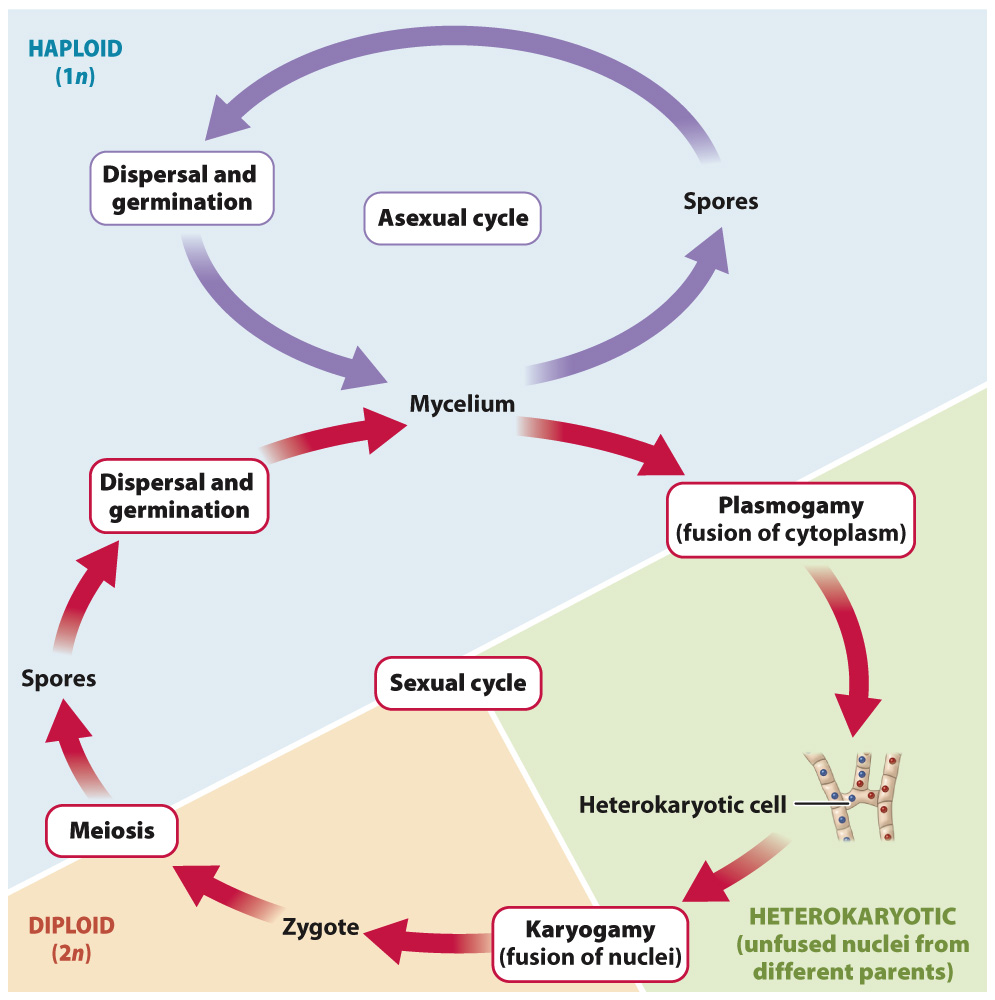The fungal life cycle often includes a stage in which haploid cells fuse, but nuclei do not.
Like other sexually reproducing eukaryotes, fungi have life cycles that include haploid (1n) and diploid (2n) stages. The nuclei in fungal hyphae are haploid, and the fungal life cycle is therefore similar to the life cycles of eukaryotic organisms that exist normally in the haploid stage (see Fig. 27.3a). In these haploid-
In most fungi, the sexual phase of the life cycle takes place through the fusion of hyphal tips rather than specialized reproductive cells, or gametes. For mating to occur, two hyphae grow together and release enzymes that digest their cell walls at the point of contact. Once the dividing wall is gone, the contents of the two hyphal cells merge, forming a single cell with two haploid nuclei. Eventually, the two haploid nuclei merge, forming a diploid zygote. The zygote divides by meiotic cell division, giving rise to sexually produced haploid spores.
724
In most sexually reproducing organisms, when two gametes merge, their nuclei fuse almost instantly to form a diploid zygote. In fungi, however, the cytoplasmic union of two cells (plasmogamy) is not always followed immediately by the fusion of their nuclei (karyogamy). Instead, the haploid nuclei retain their independent identities, resulting in what is referred to as a heterokaryotic (“different nuclei”) stage (Fig. 34.13). In the heterokaryotic stage, a cell contains nuclei from two parental hyphae, but the nuclei remain distinct. The heterokaryotic stage ends with pairs of nuclei fusing, which leads to the formation of a diploid zygote.

In some groups, the heterokaryotic stage consists of a single cell with many haploid nuclei. In other groups, plasmogamy is followed by mitosis, which produces hyphae in which each cell contains two haploid nuclei, one from each parent. Heterokaryotic cells with two genetically distinct haploid nuclei are referred to as dikaryotic, or n + n, cells. In fungi with dikaryotic cells, called dikaryotic fungi, there may be a small number of dikaryotic cells or extensively developed hyphae made up of dikaryotic cells. Some edible mushrooms found on market shelves consist entirely of dikaryotic hyphae.
Dikaryotic fungi account for more than 98% of all known fungal species, suggesting that the separation of plasmogamy and karyogamy in time and space may confer an evolutionary advantage. One such advantage can be seen when we think about the environments where fungi live. Mating takes place principally within the soil or inside the trunks of rotting trees, sites where hyphae are most likely to come into contact. Dispersal, however, is most effective when spores can be released into the air. The separation of plasmogamy and karyogamy allows mating and spore production to occur where each is most effective. In some dikaryotic fungi, however, the separation of plasmogamy and karyogamy is neither distant in space nor long in time. In these fungi, the highly branched dikaryotic hyphae may serve primarily as a means of increasing the number of cells in which karyogamy will eventually take place, therefore leading to the production of more sexually produced spores.
At present, we really don’t know why fungi proliferate n + n cells rather than forming a multicellular diploid phase, and there may be no single answer to the question of why the dikaryotic fungi have this unique cell type.
725
Quick Check 2 What is the difference between a diploid cell and a dikaryotic cell?
Quick Check 2 Answer
A diploid cell has a single nucleus with two complete sets of chromosomes; a dikaryotic cell has two genetically distinct haploid nuclei.